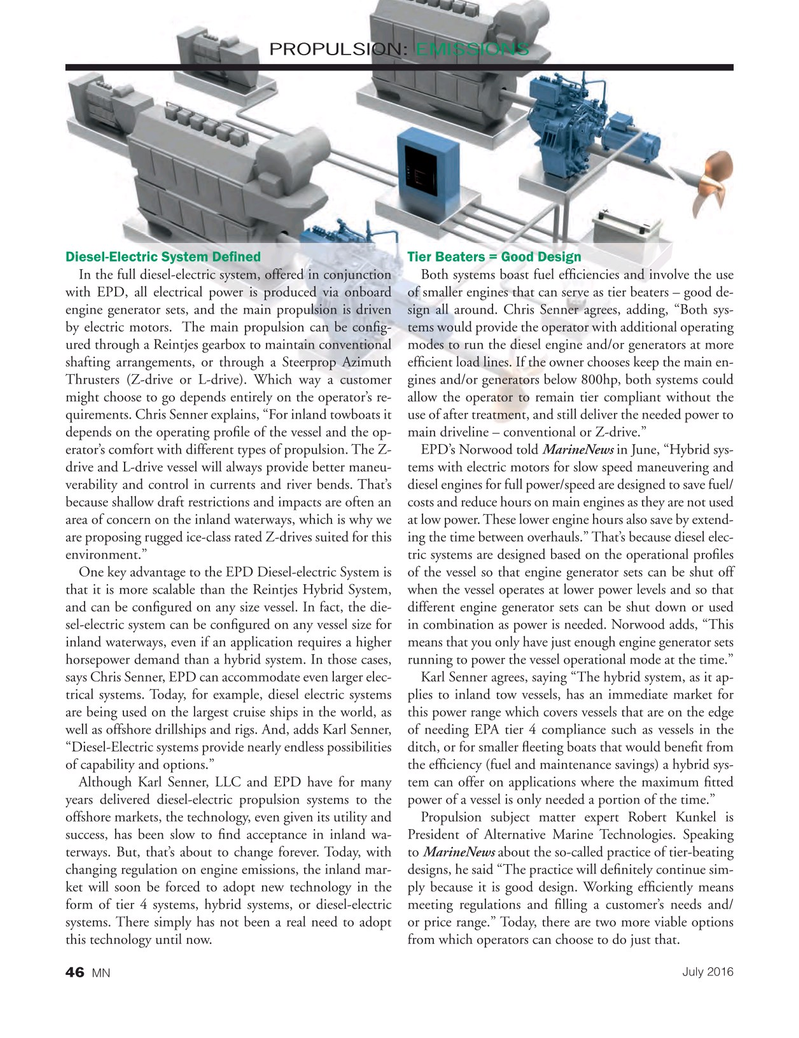
Page 46: of Marine News Magazine (July 2016)
Propulsion Technology
Read this page in Pdf, Flash or Html5 edition of July 2016 Marine News Magazine
PROPULSION: EMISSIONS
Diesel-Electric System De? ned Tier Beaters = Good Design
In the full diesel-electric system, offered in conjunction Both systems boast fuel ef? ciencies and involve the use with EPD, all electrical power is produced via onboard of smaller engines that can serve as tier beaters – good de- engine generator sets, and the main propulsion is driven sign all around. Chris Senner agrees, adding, “Both sys- by electric motors. The main propulsion can be con? g- tems would provide the operator with additional operating ured through a Reintjes gearbox to maintain conventional modes to run the diesel engine and/or generators at more shafting arrangements, or through a Steerprop Azimuth ef? cient load lines. If the owner chooses keep the main en-
Thrusters (Z-drive or L-drive). Which way a customer gines and/or generators below 800hp, both systems could might choose to go depends entirely on the operator’s re- allow the operator to remain tier compliant without the quirements. Chris Senner explains, “For inland towboats it use of after treatment, and still deliver the needed power to depends on the operating pro? le of the vessel and the op- main driveline – conventional or Z-drive.” erator’s comfort with different types of propulsion. The Z- EPD’s Norwood told MarineNews in June, “Hybrid sys- drive and L-drive vessel will always provide better maneu- tems with electric motors for slow speed maneuvering and verability and control in currents and river bends. That’s diesel engines for full power/speed are designed to save fuel/ because shallow draft restrictions and impacts are often an costs and reduce hours on main engines as they are not used area of concern on the inland waterways, which is why we at low power. These lower engine hours also save by extend- are proposing rugged ice-class rated Z-drives suited for this ing the time between overhauls.” That’s because diesel elec- environment.” tric systems are designed based on the operational pro? les
One key advantage to the EPD Diesel-electric System is of the vessel so that engine generator sets can be shut off that it is more scalable than the Reintjes Hybrid System, when the vessel operates at lower power levels and so that and can be con? gured on any size vessel. In fact, the die- different engine generator sets can be shut down or used sel-electric system can be con? gured on any vessel size for in combination as power is needed. Norwood adds, “This inland waterways, even if an application requires a higher means that you only have just enough engine generator sets horsepower demand than a hybrid system. In those cases, running to power the vessel operational mode at the time.” says Chris Senner, EPD can accommodate even larger elec- Karl Senner agrees, saying “The hybrid system, as it ap- trical systems. Today, for example, diesel electric systems plies to inland tow vessels, has an immediate market for are being used on the largest cruise ships in the world, as this power range which covers vessels that are on the edge well as offshore drillships and rigs. And, adds Karl Senner, of needing EPA tier 4 compliance such as vessels in the “Diesel-Electric systems provide nearly endless possibilities ditch, or for smaller ? eeting boats that would bene? t from of capability and options.” the ef? ciency (fuel and maintenance savings) a hybrid sys-
Although Karl Senner, LLC and EPD have for many tem can offer on applications where the maximum ? tted years delivered diesel-electric propulsion systems to the power of a vessel is only needed a portion of the time.” offshore markets, the technology, even given its utility and Propulsion subject matter expert Robert Kunkel is success, has been slow to ? nd acceptance in inland wa- President of Alternative Marine Technologies. Speaking terways. But, that’s about to change forever. Today, with to MarineNews about the so-called practice of tier-beating changing regulation on engine emissions, the inland mar- designs, he said “The practice will de? nitely continue sim- ket will soon be forced to adopt new technology in the ply because it is good design. Working ef? ciently means form of tier 4 systems, hybrid systems, or diesel-electric meeting regulations and ? lling a customer’s needs and/ systems. There simply has not been a real need to adopt or price range.” Today, there are two more viable options this technology until now. from which operators can choose to do just that.
July 2016 46 MN
MN July16 Layout 32-49.indd 46 6/20/2016 4:17:00 PM

 45
45

 47
47
